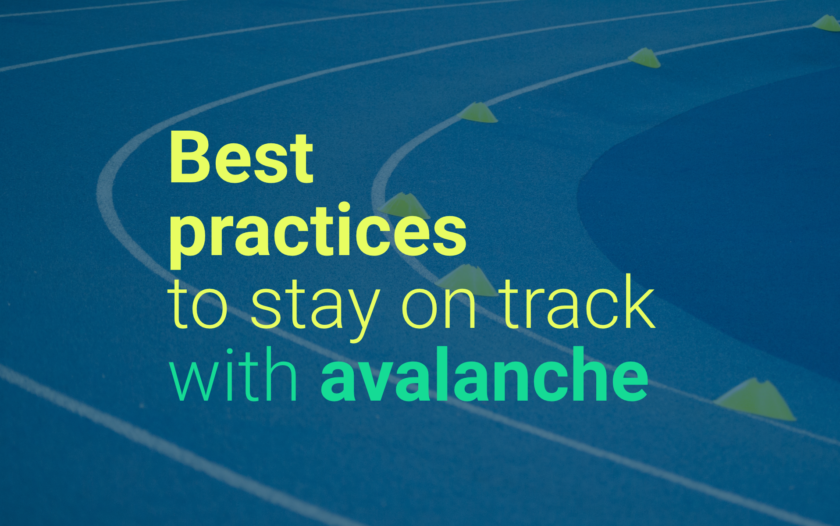Best Practices to Stay on Track with Avalanche
About Brooke
Brooke is a freelancer who focuses on the financial wellness and technology sectors. She has a passion for all things wellness and spends her days cooking up healthy recipes, running, and snuggling up with a good book and her fur babies.
Read full bio
At a Glance
The debt avalanche is one of the most popular and effective debt repayment strategies. Its power comes from the money-saving potential of paying off the highest-interest debt first. If you’ve started using this method to pay down your debts, here are some debt avalanche tips to help you stay on track.
Remember the benefits
When you started your journey to debt repayment with the debt avalanche, you likely did so because of the positive impact this strategy can have on your overall debt burden. In moments of doubt, remind yourself about the benefits of the debt avalanche, which include:
- Paying as little interest as necessary: The major benefit of the debt avalanche is that it lowers your overall interest payments. By aggressively paying down the debt with the highest interest rate, you’ll dramatically decrease the rate you’re paying across debts once the first one is paid. You can use a calculator to help increase your motivation by checking the difference in what you’ll pay over time with the debt avalanche method vs. the debt snowball.
- Simple and free to set up: Because you don’t need the help of a financial professional to set up the debt avalanche, it’s an easy, low-cost method to get started on debt repayment. And using the debt avalanche alongside other debt reduction strategies can make an even larger impact on what you owe.
Consolidate debt
If you’re carrying a lot of high-interest debt, you might have bigger savings and more success with the avalanche if you consolidate first. Debt consolidation loans can take high-interest debt like credit card debt and consolidate everything you owe into one easy monthly payment. While there are certainly pros and cons of debt consolidation, removing the burden of managing multiple payments means you can focus on putting all of your extra money toward your debt consolidation loan instead.
Keep in mind that it makes the most sense to consolidate credit card debt and other high-interest debt when you have a good credit score. A higher credit score often provides the most favorable rates and greater savings. If you’re curious how much you may be able to save, check out a debt consolidation calculator.
Consider switching to the debt snowball
If your highest-interest debt is also your largest debt, you may feel like it will be a lifetime before you begin to see progress. Sometimes switching to the debt snowball method can help you regain motivation. The debt snowball differs from the avalanche in that it encourages you to start with the smallest debt first.
Quickly paying down a minor debt is a small victory that can help you continue on your journey to debt freedom. And temporarily shifting away from the avalanche to focus on a smaller debt isn’t going to majorly hurt your savings potential either. Especially if it means you can get back to the avalanche following your quick win.
Related: How to Snowball Debt?
Consider hitting pause
It may surprise you that one of the debt avalanche best practices is to hit pause. But it could make sense to pause your debt avalanche repayment strategy when you have a major financial event, and could help you stay the course in the long run. Some examples of an appropriate time to pause the avalanche are when you:
- Have a baby
- Have tax debt
- Lose your job
- Divorce
- Face a health crisis for you or a loved one
In these significant life situations, you’ll want to take care of the task at hand and pull back your intensity on the debt avalanche. But be sure to get back on track as quickly as possible once your life situation allows.
Get help if you need
Debt repayment is a long and arduous journey. But know that wherever you are, there are resources available to help. You can consult with a trusted friend or family member, credit counselor, or financial advisor. Sometimes seeking out the assistance of a professional can be reassuring that you’re on the right path.
If these debt avalanche tips aren’t working and you’re ready to give up on debt payments entirely, debt settlement programs are the last resort to consider. The process of trying to get lenders to negotiate and settle for a smaller payment will often have negative implications for your credit score. So it’s best to try and stick to a repayment plan and pay what’s due in total if you can.
Bottom line
When you feel like you may not be able to stay on track, remember that there are debt avalanche best practices you can lean on. Remember why you started, look into debt consolidation, consider switching to the debt snowball, hit pause if you have to, and know that there is always professional help if you need it. Staying the course with the debt avalanche is a sure way to save money and keep you on the straight and narrow path toward debt freedom.









